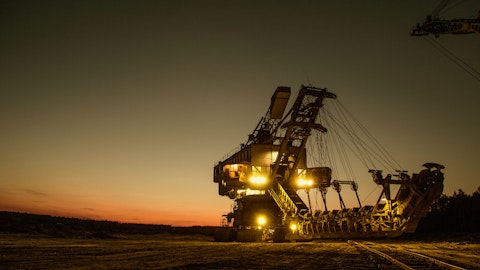Joanne Jobin: Okay. As you can imagine, there’s lots of questions on the SOQUEM deal. So, how did it come about? And was there a bidding process? Can you get a little more granular with that deal for us?
David Garofalo: Yeah, I’m happy to. Look, time and again, since our IPO in 2021, we’ve been able to demonstrate that leveraging the relationship that our Board and Management have with collectively 400 years of industry experience, has led to significant growth. Virtually every deal that we’ve done since our origination has been on an exclusive basis. And so it’s leveraging a relationship that a couple of our Management and Board members had with the Executives at SOQUEM. You’ll remember, I was in Northwestern Quebec for many, many years with Agnico Eagle. So I have relationships within the Quebec institutions as well. And that was meaningful in terms of getting this exclusively negotiated with SOQUEM. But, I think more meaningfully, it opens us up for future deals with SOQUEM.
Now that we’ve established this relationship, we have a formal commercial arrangement as they continue to invest in the normal course in exploration in Quebec, which is fundamental to their mandate, they’re going to generate more royalties and they’re going to look for a way to monetize those royalties within a vehicle, a public vehicle like Gold Royalty. So hopefully, I can’t guarantee it will be exclusive going forward, but hopefully, now that we’ve established the structure is something that we can leverage, time and again, through that strong fundamental relationship with SOQUEM.
Joanne Jobin: Okay. And I guess the question that I keep getting asked here is like, why wouldn’t they just keep the $1 million and take the proceeds from the royalties? Why did they parcel off or spin out their royalties?
David Garofalo: SOQUEM’s mandate is not to hold on to these assets forever. Their mandate is to incentivize exploration in the ground in Quebec, make those investments to catalyze growth in reserves and resources across a broad spectrum of metals, not just precious metals, and ultimately exit those positions over time and recycle that capital into new exploration opportunities. So holding on to those royalties forever, doesn’t really fit their mandate. They’re looking to put new capital back to work out in the ground and this will provide them some capital they can use over time to reinvest back into exploration in Quebec, which is, again, fundamental to their mandate.
Joanne Jobin: Okay. And the last question on SOQUEM is, clearly it’s hard to model at this early stage, but do you have any metrics of how this deal actually looks and shakes out in the end for Gold Royalty?
David Garofalo: There’s a couple of ways to look at it. Peter talked about the $18 million of buy downs within the royalty contracts, of which, we will get 50%. So, in a very aggressive scenario, assuming all those got bought down, we will get 9 times our money back in just cash. So that’s excluding any option value fundamental to those royalties. The other way of looking at it is, we got 20 royalties for the equivalent of US$600,000, so that’s about $30,000 of royalty. It’s comparable to what our royalty generator model costs in terms of staking, claims, the salaries of our people down in Reno. So very comparable to generating royalties organically in terms of the entry cost. So very, very cost-effective way to add additional royalty optionality into the portfolio.
Joanne Jobin: Okay. And let’s talk about focused on precious metals in North America, and I’m going to combine this with another question from someone regarding platinum pricing and gold is nearing the cheapest valuations ever. Are we entering the platinum streams in royalty contracts?
David Garofalo: Yeah. Look, we’re going to stay focused on LME-traded metals ones that are quite liquid. If you look at our Board and Management, including myself, I’ve spent equal amounts of time in my career based on precious, I’ve built copper, zinc, silver, and gold mines over the course of my career, nickel, those metals are ones that we understand where we think we add value. Some of the more exotic, less liquid metals are something that you really wouldn’t see I said. If it’s in context of a polymetallic deposit, that has those core minerals in them. That’s certainly something that we would look at. But, we’re going to be precious metal focused with some diversification into some of those LME metals.
Peter Behncke: David, I would just expand on that looking at the platinum and palladium commodities. We do see the argument there as including that within the precious metals bucket. But, with that said, the quantity of opportunities we see in that space relative to the much larger gold, silver, copper commodity space is much smaller. We’ve looked at over 300 opportunities since we went public, and only executed on a handful of those. I’d note, of those 300-plus opportunities, the vast majority were gold, silver, and then some copper opportunities as well. So we’ll look at high-quality opportunities across the commodity spectrum, but consistently, we’re seeing what we’ve been able to close on.
Joanne Jobin: Okay. Let’s go back to your portfolio. How much of your revenue is expected to be generated or come from Odyssey next year? And what does the ramp look like over the next several years in terms of expected revenue?
